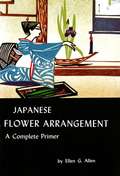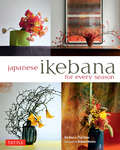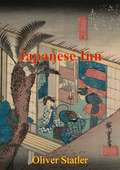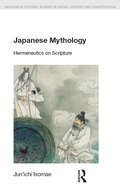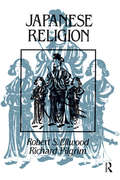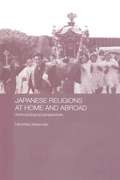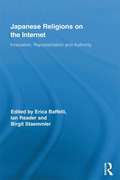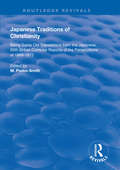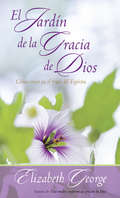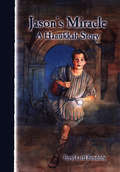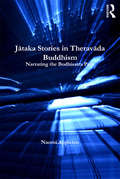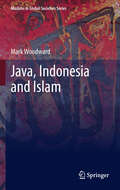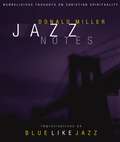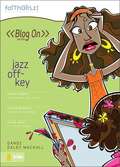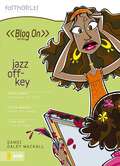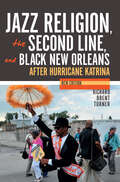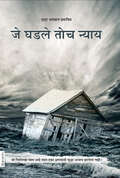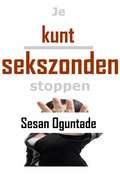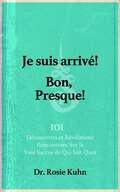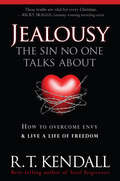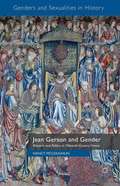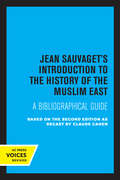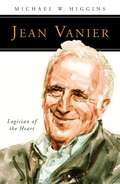- Table View
- List View
Japanese Flower Arrangement: A Complete Primer
by Ellen G. AllenThere is something of the artist in each of us. Some of us find expression in painting, poetry, or sculpture, some in landscape gardening. With talent and facility, expression in these art forms is Satisfying. <P><P>And this is true also of flower arranging, an ancient art that can express a thought or mood and in a sense combine the expression of severnl other media. Yet special talent for flower arranging is not essential. The 'feeling' for it is engendered by the practice of it!' With these words Ellen Gordon Allen begins the introduction to her eminently practical primer of Japanese flower arrangement, which is here being offered in a new revised edition. As a certified teacher (Oharn school)and a very successful one, Mrs. Allen is well qualified to present her subject.The purpose of her book is fourfold: to increase the skill of all who love to arrange flowers to provide a more comprehensive understanding of the Japanese art of flower arrangement; to help students when no teacher is available; andto provide a medium of instruction among the many, often confusing, schools of Japoncse flower arrangement. It is Mrs. Allen's hope that the primer will serve as a practical handbook for beginners and that it will dispel the aura ofmystery that seems to surround the subject. To this end, she has made her instructions as elementary as possible. The few fundamental rules of Japanese flower arrangement and the various techniques are presented in a simple manner.Wherever possible, English equivalents have been substituted for Japanese terms. Each lesson sketches, photographs, and diagrams which clearly show the student what to do in working toward completion of the arrangement. Although Mrs. Allen teaches principally the methods of the Ohara school for the moribana and heika styles and the methods of the Saga school for the seika style, her book is also a compilation of information from the Sogetsu, the Ikenobo, the Sho-fu·ryu, and other famous schools in Japan. She has selected what she considers most practical for use in the American or other foreign setting. By using the slep-by-step methods outlined in the 14 well-organized lessons, the Rowerarrangementstudent will not only be able to learn rapidly but will also experience the pleasure of making genuine progress in an art that provides an endless source of enjoyment. And, as Mrs. A1len expresses it, "it is the enjoyment of making flower arrangements that I want particularly to stress. Learn the fundamentalsand you will enjoy their application, sharing your pleasure with others who will marvel at your skill in arranging flowers."
Japanese Ikebana for Every Season
by Noboru Murata Yuji Ueno Rie ImaiThe true meaning of Ikebana-the traditional Japanese art of flower arrangement-is the ability to take a few beautiful flowers and plans and tastefully present them in very simple containers to decorate your home. Whether for Mother's Day, Valentine's Day, or a special birthday or anniversary-Japanese Ikebana for Every Season simplifies and demystifies this ancient art by presenting 53 elegantly simple arrangements that anyone can create at anytime at home.The key to good Ikebana arrangements is to understand a few very simple principles-like the idea of mitate-seeing old things with new eyes, as well as learning a few very easy techniques of flower stabilization and how to support plants and flowers inside a vase or container. Using simple, common flowers and plants from your garden, from a nearby field or forest, or from your local florist-you can easily create these lovely Ikebana in just a few minutes if you know how.Authors Rie Imai and Yuji Ueno explain how to select the flowers and the containers by simply using things that are already around you-and then they show you how to turn them into something special. The basic instructions in the book cover a wide range of styles that encourage readers to use their own creativity rather than copying traditional and highly technical Ikebana design concepts.No matter what time of year it is and regardless of your taste or budget-the arrangements in this book will lend a touch of Japanese elegance to your home!
Japanese Inn: A Reconstruction Of The Past
by Oliver StatlerThe beguiling story of the Minaguchi-ya, an ancient inn on the Tokaido Road, founded on the eve of the establishment of the Tokugawa shogunate. Travellers and guests flow into and past the inn -- warriors on the march, lovers fleeing to a new life, pilgrims on their merry expeditions, great men going to and from the capital. The story of the Minaguchi-ya is a social history of Japan through 400 years, a ringside seat to some of the most stirring events of a stirring period.'Statler has created a strangely beautiful book that succeeds in conveying intact not only a great deal of its history but the mood of that land. The result is sheer delight. Japanese Inn is the work of a master craftsman; it is so well conceived that the narrative moves from past to present in the same paragraph without the slightest confusion to the reader; it is so well written that only in retrospect is one aware of its remarkable flawless style. Through the author's particular magic, the stories unfold as one narrative, as beautifully and memorably as the unrolling of a long Japanese scroll.'--CURT GENTRY'The reader learns much of Japan's past -- and, as is inevitable in a study of that country, of present-day Japanese as well. Mr Statler's prose succeeds in evoking the pageantry of the past in the brilliant color of the kabuki stage. Nothing seems to have been overlooked by the author. Mr Statler's book is Japanese history made easy, and grand entertainment.'-- NEW YORK TIMES BOOK REVIEW'Much of it is told in fictional form. Some of the episodes have come out of family annals and memories, some from the records of the temple; some are imagined; but all could have happened ... Mr Statler has told the story vividly and with sympathy. It moves. It has the authentic feel of Japan.'--INTERNATIONAL HERALD TRIBUNE
Japanese Mythology: Hermeneutics on Scripture (Religion in Culture)
by Jun'ichi Isomae Mukund SubramanianBefore the westernisation of Japan, mythological events were treated as national history. Two key documents have contributed to this history, both written over 1300 years ago: 'Kojiki', the Tale of Old Age, and 'Nihonshoki', the Chronicle of Japanese History. Both the Imperial Court and the general public searched for the origin of their identity in these documents, which took on the central and sacred role of scripture. Through the act of commentary and interpretation, the sacred books connected interpreters to their historical origins, authenticating where they came from, the emergence of the Japanese archipelago, and the uniqueness of the Japanese people. 'Japanese Mythology' explores the nation's attraction to this act of historical grounding and the varying identities that emerged during different historical periods. The study reveals that, rather than having any clear and unified substance, Japanese mythology has always been the result of a nostalgic desire to retrieve historical origins.
Japanese Religion: A Cultural Perspective
by Robert Ellwood Richard PilgrimThis book provides an overview of religion in Japan, from ancient times to the present. It also emphasizes the cultural and attitudinal manifestations of religion in Japan, withough neglecting dates and places.
Japanese Religions and Globalization
by Ugo DessìThis book analyzes the variety of ways through which Japanese religions (Buddhism, Shintō, and new religious movements) contribute to the dynamics of accelerated globalization in recent decades. It looks at how Japanese religions provide material to cultural global flows, thus acting as carriers of globalization, and how they respond to these flows by shaping new glocal identities. The book highlights how, paradoxically, these processes of religious hybridization may be closely intertwined with the promotion of cultural chauvinism. It shows how on the one hand religion in Japan is engaged in border negotiation with global subsystems such as politics, secular education, and science, and how on the other hand, it tries to find new legitimation by addressing pressing global problems such as war, the environmental crisis, and economic disparities left unsolved by the dominant subsystems. A significant contribution to advancing an understanding of modern Japanese religious life, this book is of interest to academics working in the fields of Japanese Studies, Asian history and religion and the sociology of religion.
Japanese Religions at Home and Abroad: Anthropological Perspectives
by Hirochika NakamakiIn this important book, a leading authority on Japanese religions brings together for the first time in English his extensive work on the subject. The book is important both for what it reveals about Japanese religions, and also because it demonstrates for western readers the distinctive Japanese approaches to the study of the subject and the different Japanese intellectual traditions which inform it. The book includes historical, cultural, regional and social approaches, and explains historical changes and regional differences. It goes on to provide cultural and symbolic analyses of festivals to reveal their full meanings, and examines Japanese religions among Japanese and non-Japanese communities abroad, exploring the key role of religion in defining Japanese ethnic identity outside Japan.
Japanese Religions on the Internet: Innovation, Representation, and Authority (Routledge Research in Religion, Media and Culture)
by Ian Reader Erica Baffelli Birgit StaemmlerJapanese Religions on the Internet draws attention to how religion is being presented, represented and discussed on the Japanese Internet. Its intention is to contribute to wider discussions about religion and the Internet by providing an important example – based on one of the Internet’s most prominent languages – of how new media technologies are being used and are impacting on religion in the East-Asian context, while also developing further our understandings of religion in a technologically advanced country. Scholars studying the relationship of religion and the Internet can no longer work on prevailing notions that have thus far characterised the field, such as the assumption that the Internet is a Western-centric phenomenon and that studies of English-language sites relating to religion can provide a viable model for wider analyses of the topic. Despite this growing amount of research on religion and the Internet, comparatively little has focused on non-Western cultures. The general field of study relating to religion and the Internet has paid scant attention to Asian contexts. The field needs a full-length and comprehensive study that focuses on the Japanese religious world and the Internet, not merely to redress the imbalances of the field thus far, but also because such studies will be central to the emerging field of the study of religion and the Internet in future. They will provide important means of developing new theories, constructing new paradigms and understanding the underlying dynamics of this new media form.
Japanese Traditions of Christianity (Routledge Revivals)
by M Paske-SmithPublished in 1930, this book traces the long history of Christianity in Japan. Paske-Smith details the journey of the early missionaries from the west, the conflict that arose from the introduction of Christianity to Japan and how Christianity’s influence transformed some of the Japanese cultural landscape.
Jardin de la gracia de Dios: Cómo crecer en el fruto del Espíritu
by Elizabeth GeorgeUna invitación a toda mujer a experimentar en su vida el fruto del Espíritu de Dios. Este libro enseña cómo darle su lugar en cada parte de la vida y como las mujeres pueden permitir que la gracia de Dios resplandezca en ellas para bien de otros.An invitation for women to welcome the fruit of the Spirit into their lives.
Jason's Miracle
by Beryl Lieff BenderlyIt's the first night of Hanukkah, and Jason is frustrated and upset. Christmas is everywhere, and his family won't celebrate it even a little. His dad is firm in his beliefs about the miracle of Hanukkah. But Jason gains a new perspective when he is transported back in time and welcomed as a friend of the Maccabees. With Jason's help, the Maccabees are able to defeat the Syrians, regain Jerusalem, and witness the miracle of the lights.
Jataka Stories in Theravada Buddhism: Narrating the Bodhisatta Path
by Naomi AppletonJataka stories (stories about the previous births of the Buddha) are very popular in Theravada Buddhist countries, where they are found in both canonical texts and later compositions and collections, and are commonly used in sermons, children's books, plays, poetry, temple illustrations, rituals and festivals. Whilst at first glance many of the stories look like common fables or folktales, Buddhist tradition tells us that the stories illustrate the gradual path to perfection exemplified by the Buddha in his previous births, when he was a bodhisatta (buddha-to-be). Jataka stories have had a long and colourful history, closely intertwined with the development of doctrines about the Buddha, the path to buddhahood, and how Buddhists should behave now the Buddha is no more. This book explores the shifting role of the stories in Buddhist doctrine, practice, and creative expression, finally placing this integral Buddhist genre back in the centre of scholarly understandings of the religion.
Java, Indonesia and Islam
by Mark WoodwardMark R. Woodward's Islam in Java: Normative Piety and Mysticism in the Sultanate of Yogyakarta (1989) was one of the most important work on Indonesian Islam of the era. This new volume, Java, Indonesia, and Islam, builds on the earlier study, but also goes beyond it in important ways. Written on the basis of Woodward's thirty years of research on Javanese Islam in a Yogyakarta (south-central Java) setting, the book presents a much-needed collection of essays concerning Javanese Islamic texts, ritual, sacred space, situated in Javanese and Indonesian political contexts. With a number of entirely new essays as well as significantly revised versions of essays this book is a valuable contribution to the academic community by an eminent anthropologist and key authority on Islamic religion and culture in Java.
Jazz Notes: Improvisations on Blue Like Jazz
by Donald MillerJazz Notes is the literary equivalent of a remix CD-cool sound-bytes strategically crafted from Don Miller's classic Blue Like Jazz, combined with brand new material that offers the author's fans an inside look at some of the unforgettable-and outrageous-characters and stories from the original best seller. Jazz Notes captures the essential Don Miller with non-religious reflections on how Don's incredible spiritual odyssey got started; what happened to Don at one of the most liberal colleges in the world to help him experience faith and grace for the first time in his life; a recasting of Don's marvelous "confession booth" story; and how Don discovered the secret to really loving other people-and himself.
Jazz Off-Key
by Dandi Daley MackallJazz is thrilled at the chance for her own one-woman art show during Big Lake's Spring Fling celebration, but when her younger sister, Kendra, who has special needs, ruins the paintings she had planned to display Jazz rages at family and friends while wishing she could find peace through Jesus.
Jazz Off-Key (Faithgirlz / Blog On! #7)
by Dandi Daley MackallWritten by bestselling author Dandi Daley mackall, in this series girls use Internet technology to unite and connect in powerful new ways. Discover a world where girls come together from completely different backgrounds and beliefs to start a journey of faith and self-discovery. When Jazz gets her big break—her own one-woman art show for Big Lake’s Spring Fling celebration—she’s ecstatic … until Kendra, her special needs sister, ruins her paintings by trying to make them happier and more colorful. Jazz discovers she can’t control her anger, and her rage at family and friends grows to the point that she recognizes the need for Christ to cover her sins and change her from the inside. DANDI DALEY MACKALL won her first writing contest when she was ten years old with fifty words on why she wanted to be a batboy. She won, but they wouldn’t let a girl be a batboy. It was her first taste of rejection. She bounced back and has since published 400 books. Dandi lives in rural West Salem, OH, and enjoys her husband and kids, who will still, on occasion, be up for a game of family softball.
Jazz Religion, the Second Line, and Black New Orleans: After Hurricane Katrina
by Richard Brent TurnerThis scholarly study demonstrates “that while post-Hurricane Katrina New Orleans is changing, the vibrant traditions of jazz . . . must continue” (Journal of African American History).An examination of the musical, religious, and political landscape of black New Orleans before and after Hurricane Katrina, this revised edition looks at how these factors play out in a new millennium of global apartheid. Richard Brent Turner explores the history and contemporary significance of second lines—the group of dancers who follow the first procession of church and club members, brass bands, and grand marshals in black New Orleans’s jazz street parades.Here music and religion interplay, and Turner’s study reveals how these identities and traditions from Haiti and West and Central Africa are reinterpreted. He also describes how second line participants create their own social space and become proficient in the arts of political disguise, resistance, and performance.
Je Ghadle Toch Nyay: जे घडले तोच न्याय
by Dada Bhagwanनिसर्गाच्या न्यायाला जर तुम्ही ह्या प्रकारे समजलात की “जे घडले तोच न्याय” तर तुम्ही ह्या संसारातून मुक्त होऊन जाल. लोक जीवनात न्याय आणि मुक्ती एकत्र शोधतात. ही पूर्ण विरोधाभासाची स्थिती आहे. हे दोन्ही तुम्हाला एकत्र मिळूच शकत नाहीत. प्रश्नांचा अंत आल्यावरच मुक्तीची सुरुवात होते. "अक्रम विज्ञानात" सर्व प्रश्नांचा अंत येतो, म्हणून हा खूपच सरळ मार्ग आहे. दादाश्रींचा हा मौल्यवान शोध आहे की निसर्ग कधीही अन्यायी झालेला नाही. जग हे न्यायस्वरूपच आहे. जे घडले तो न्यायच आहे. निसर्ग काही व्यक्ती किंवा देव नाही की ज्याच्यावर कोणाची सत्ता चालू शकेल. निसर्ग म्हणजे "साइंटिफिक सर्कम्स्टॅन्शियल एव्हिडेन्स”. कितीतरी संयोग (योगायोग) एकत्र आले की मग कार्य होते. दादाश्रींच्या ह्या संकलनात "जे घडले तोच न्याय" चे विज्ञान प्रस्तुत केले आहे. ह्या सूत्राचा जीवनात जेवढा उपयोग होईल, तेवढीच शांती वाढेल.
Je kunt sekszonden stoppen
by Sesan OguntadeDit is een praktische christelijke gids over hoe tieners, volwassenen, getrouwde mannen en vrouwen weg kunnen blijven van seksuele zonden. Als je persoonlijk weg wilt blijven van seksuele zonden of als je een tienermeisje hebt dat je graag haar maagdelijkheid wilt behouden, dan zal dit boek je enorm helpen. Getrouwde mannen en vrouwen die hun echtgenoten ontrouw zijn geweest, maar die echt hun wegen willen veranderen, zullen ook van dit boek houden. 30 praktische tips en verhalen over hoe iemand maagd kan blijven, seksuele zonden kan vermijden of stoppen en in volledige harmonie met God kan leven, worden in dit boek besproken. De praktische verhalen van drie personen die bittere lessen hebben geleerd van hun verkeerde gebruik van seks zijn in dit boek gebruikt; je zult genieten en leren van hun verhalen. Het is een andere geweldige christelijke gids over het stoppen van seksuele zonden van de auteur van You Can Stop Masturbation. Grijp vandaag nog jouw exemplaar van You Can Stop Sex Sins.
Je suis arrivé! Bon, Presque!: 101 Découvertes et Révélations Rencontrées Sur la Voie Sacrée de Qui Sait Quoi
by Dr Rosie KuhnLa voie vers une vie éveillée n’est pas tracée directement en face de nous. Ça n’apparaît pas miraculeusement par magie du jour au lendemain, ou après une réalisation spirituelle unique. La voie du Dr. Rosie Kuhn, psychologue et coach transformationnel n’est pas différente. Sa voie avait commencé à travers un engagement pour explorer la frontière extérieure de l’épanouissement et c’est devenu qui sait quoi. Alors que Dr. Rosie avançait vers l’éveil, plusieurs découvertes et révélations ont jalonné son parcours. Grâce à une conviction profonde, de l’entrainement et la pratique, elle est capable de s’aligner avec sa vérité supérieure. A travers le récit de son propre vécu, Dr. Rosie enseigne les mécanismes de l’exercice et propose l’expérimentation de la saveur de la foi permettant ainsi à l’extraordinaire de se produire, aussi bien pour elle que pour vous.
Jealousy in Context: The Social Implications of Emotions in the Hebrew Bible (Siphrut)
by Erin VillarealAttested as both a human and a divine expression, the biblical Hebrew term qinʾâ is most often translated as “jealousy” or “envy.” In this study, Erin Villareal makes the case for reading qinʾâ as more than a simple reference to an emotion, instead locating the term’s origins in ancient Israel’s social and legal spheres.Jealousy in Context evaluates the socioliterary context of qinʾâ. Through a series of case studies examining this term as it is applied to residents, sister-wives, brothers, and husbands in biblical narrative passages, Villareal explains that qinʾâ is felt by people who experience a threat or disruption to their rights and status within a social arrangement or community and is therefore grounded in practical concerns that have social and juridical ramifications. Investigating examples of divine qinʾâ, Villareal shows that its social meaning was adapted into theological language about the Israelite deity and his relationship with the people of Israel, and that Yahweh expresses qinʾâ whenever there is a threat to the integrity of his land or his sanctuary. Villareal examines the term through this socioliterary lens to reveal ancient Israelite perceptions concerning social organization and divine-human relationships. Additionally, she explores how the socioliterary character of qinʾâ in the Hebrew Bible communicates representations of ancient Israelite beliefs, values, and social expectations.This convincing new understanding of a key biblical term will be appreciated by students and scholars of the Hebrew Bible, Hebrew linguistics, and ancient Near Eastern societies more generally.
Jealousy--The Sin No One Talks about: How to Overcome Envy and Live a Life of Freedom
by R.T. KendallJealousy. We all have to deal with it--both in ourselves and in others. Jealousy is rooted in our natural fears and insecurities. It has damaged relationships since the time of Cain and Abel, and still does today if we let it. In this wise and compassionate book, R.T. Kendall tackles, head-on, the sin that no one likes to admit to. He shows that it is only when we grasp that it is God we should aim to please that we will be able to recognize and overcome jealousy and, like Jesus, be jealous only for the glory of God.
Jean Gerson and Gender
by Nancy McloughlinJean Gerson and Gender reconciles the somewhat enigmatic legacy of one of the most influential late medieval intellectuals: the theologian, court preacher, university chancellor, and church reformer, Jean Gerson (d. 1429). Gerson provided foundational contributions to two historical developments: the promotion of rational and just government, and the development of the European concept of the witch. This book argues that Gerson's association of royal and ascetic women with sin and diabolical influences allowed him to maintain - against overwhelming evidence to the contrary – the appearance of centralized monarchical rule, a stable ecclesiastical hierarchy, and a reliable method for constructing communally verifiable political and religious truths.
Jean Sauvaget's Introduction to the History of the Muslim East: A Bibliographical Guide
by Claude Cahen Jean SauvagetThis title is part of UC Press's Voices Revived program, which commemorates University of California Press’s mission to seek out and cultivate the brightest minds and give them voice, reach, and impact. Drawing on a backlist dating to 1893, Voices Revived makes high-quality, peer-reviewed scholarship accessible once again using print-on-demand technology. This title was originally published in 1965.
Jean Vanier: Logician of the Heart (People of God)
by Michael HigginsJean Vanier, Winner of the 2015 Templeton Prize and numerous other international and prestigious honors, Jean Vanier lives a radical poverty of surrender in a time of fanatical acquisitiveness, economic disparity, and mounting bellicosity among nations. He is a philosopher of the heart, icon of wholeness, and justice activist. Through such key notions as trust, community, relationship, and humility, Vanier has built up a network of service and nurturing growth spanning the globe: the L'Arche Movement. He has advocated for peace in a world that treasures its violence, written extensively about the very meaning of human personhood, and championed sensitivity to the diverse spiritual traditions that make up our world. His remarkable life has included rich friendships with Blessed Mother Teresa, St. John Paul II and Henri Nouwen. Jean Vanier is a man of complexity and formal philosophical training, a scion of a family of national pedigree, and one of the seminal religious and inspirational figures of our time. In this volume, Michael Higgins focuses on Vanier’s many interconnections—personal and conceptual—with the mighty and the humble, the pious and the secular, as well as the young and the seasoned.
